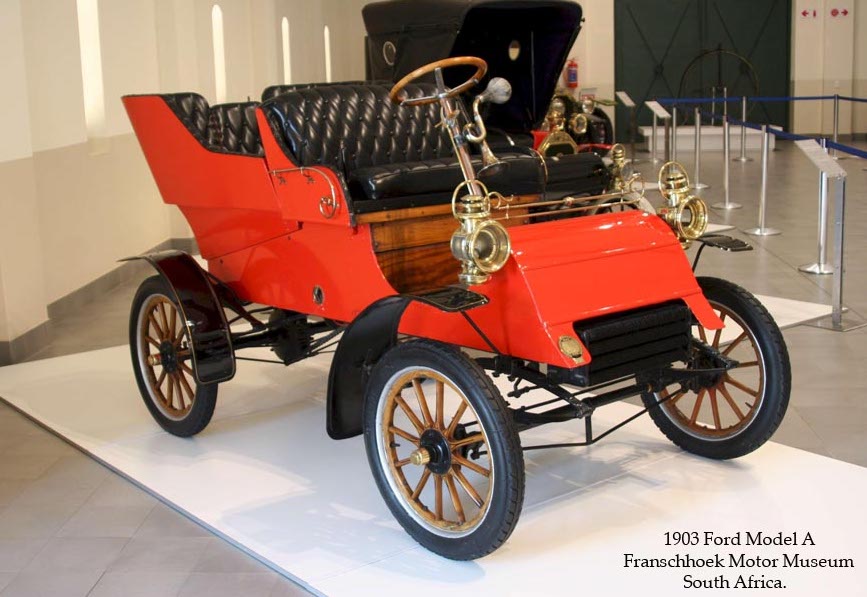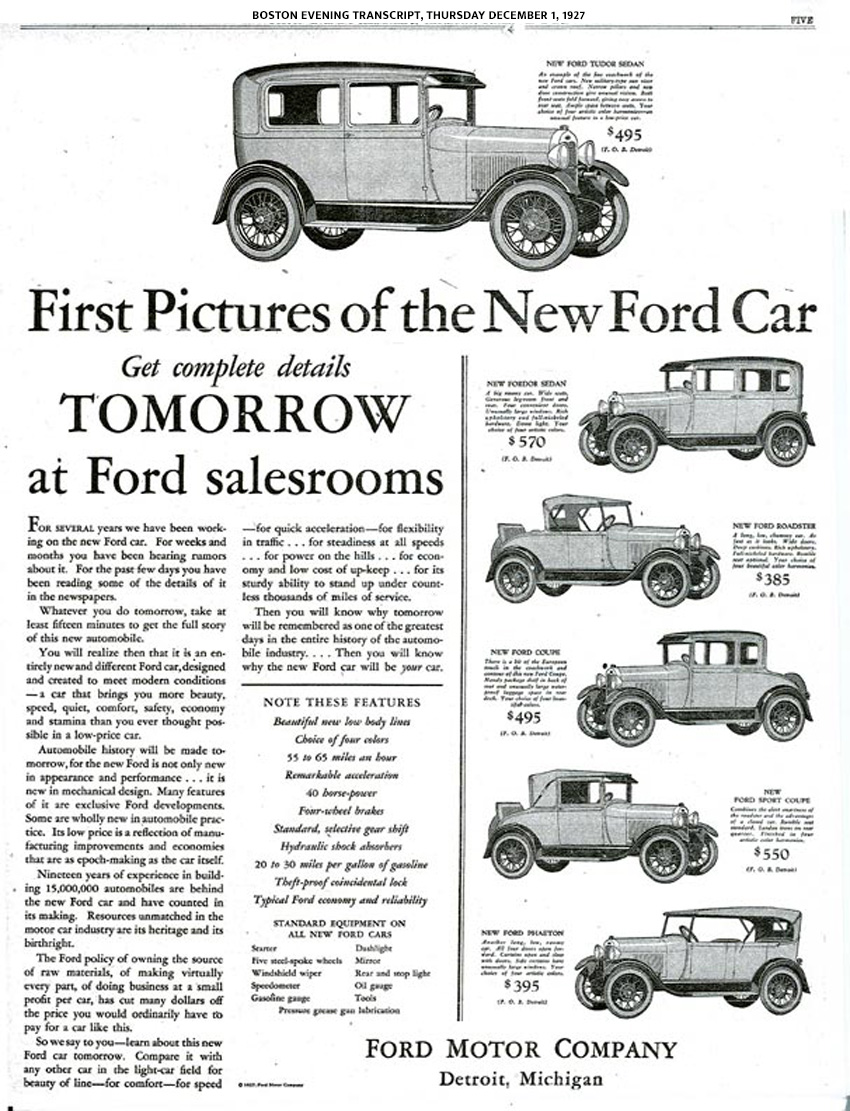Ford History
Henry Ford, 1863-1947, built his first vehicle, the Quadricycle, in 1896 at the age of 32. His first car was a simple frame with a gas-powered engine and four bicycle wheels mounted on it. The invention of the Quadricycle marks an important innovation as a proto-automobile that would lay the foundation for the future, with more practical designs to follow. The success of the little vehicle led to the founding of the Henry Ford Company and then later the Ford Motor Company in 1903.
 The Ford Motor Company's first vehicle was called the Model A, introduced in 1903 and produced for two years. Dr. Ernst Pfenning of Chicago, Illinois became the first owner of a Model A on July 23, 1903. 1,750 cars were made from 1903 through 1904. The Model A was replaced by the Ford Model C during 1904. Henry kept refining and experimenting with different vehicles, naming each after a letter of the alphabet.
The Ford Motor Company's first vehicle was called the Model A, introduced in 1903 and produced for two years. Dr. Ernst Pfenning of Chicago, Illinois became the first owner of a Model A on July 23, 1903. 1,750 cars were made from 1903 through 1904. The Model A was replaced by the Ford Model C during 1904. Henry kept refining and experimenting with different vehicles, naming each after a letter of the alphabet.
- The Model B was introduced in 1904 and sold through 1906
- The Model C was produced from 1904-1905
- The Model F was produced from 1905-1906
- The Model K was produced in 1906-1908 and was the first 6-cylinder Ford - at $2500,
it was too expensive and didn't sell well. - The Model N was introduced in 1906 to replace the Model A, C, and F series. It sold until 1908. It was the first 4-cylinder Ford.
- The Model R was only sold in 1907. It was an updated version of the Model N
- The Model S was sold from 1907-1909.
- The Model T was introduced in October 1908 and with many changes over the years, continued in production until May 1927.
See Ritz Ford Site. Holland for a discussion of the early Ford Models
The Beginnings of the Model A Ford (1928-1931)

Ford produced the last Model T in May 1927 and shut down production after more than 15,000,000 Model Ts were built in order to tool up for the new model. The very first Model A engine was completed at the Rouge plant in October, 1927 and was placed in a 1928 Tudor Sedan, which Henry Ford gave to his close friend Thomas Edison.
Ford was very secretive during this time; there was no news about the new Ford model until the day before the car was introduced on December 2, 1927.
Advertisements ran in newspapers all across the country showing the pictures of the 6 new models: the Tudor, Fordor, Roadster, Coupe, Sport Coupe, and Phaeton.
Prices ranged from $385 for the Roadster to $570 for the Fordor Sedan.
Millions of people flooded Ford showrooms to get a glimpse of the New Ford. Very few cars were actually available at that time. As of January 1, 1928, only 5275 engines had been produced, and not all of them had been installed in a chassis and shipped to a dealer.
When Model A production ended in March, 1932, there had been 4,849,340 Model As made in all styles. Its successor was the 1932 Model B, which featured an updated 4-cylinder engine, and the 1932 Model 18, which introduced Ford's new V8 engine.
Related Sites
- Henry Ford - The Face of 20th Century Innovation - from Buy Auto Insurance
- Henry Ford History -- The Story of the Model A from The Auto Channel
- The Model T Story - The Model T Ford Club offers the history behind our 2nd favorite Ford model!
- Henry Ford Biography - this is a part of the Henry Ford/Thomas Edison Winter Estate pages in Fort Myers, Florida.
- Fair Lane - Henry Ford's Estate. The Henry Ford Estate - Fair Lane, a National Historic Landmark on the campus of the University of Michigan-Dearborn, is the former home of automaker Henry Ford and his wife Clara. The Fords lived at Fair Lane from 1915 until their deaths in 1947 and 1950.
-
Greenfield Village - Dearborn, Michigan - Henry Ford Museum & Greenfield Village, the nation's largest indoor/outdoor museum complex, was founded by Henry Ford in 1929. With more than 1 million visitors a year, the complex seeks to demonstrate the process of change and innovation as a continuing value in American life. Henry Ford Museum & Greenfield Village provides unique educational experiences based on authentic objects, stories, and lives from America's traditions œof ingenuity, resourcefulness, and innovation. Our purpose is to inspire people to learn from these traditions to help shape a better future. See also: Artcom Museum's List.





